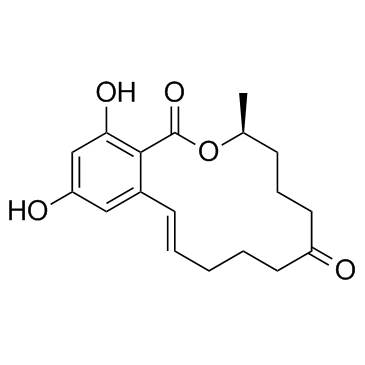Zearalenone

Zearalenone structure
|
Common Name | Zearalenone | ||
|---|---|---|---|---|
| CAS Number | 17924-92-4 | Molecular Weight | 318.364 | |
| Density | 1.2±0.1 g/cm3 | Boiling Point | 600.4±55.0 °C at 760 mmHg | |
| Molecular Formula | C18H22O5 | Melting Point | 164-165°C | |
| MSDS | Chinese USA | Flash Point | 219.5±25.0 °C | |
| Symbol |


GHS02, GHS07 |
Signal Word | Danger | |
|
Deoxynivalenol-mimic nanobody isolated from a naïve phage display nanobody library and its application in immunoassay.
Anal. Chim. Acta 887 , 201-8, (2015) In this study, using mycotoxin deoxynivalenol (DON) as a model hapten, we developed a nanobody-based environmental friendly immunoassay for sensitive detection of DON. Two nanobodies (N-28 and N-31) which bind to anti-DON monoclonal antibody (MAb) were isolat... |
|
|
Mitochondrial proteomic analysis reveals the molecular mechanisms underlying reproductive toxicity of zearalenone in MLTC-1 cells.
Toxicology 324 , 55-67, (2014) Zearalenone (ZEA), a Fusarium mycotoxin that contaminates cereal crops worldwide, has been shown to affect the male reproductive system and trigger reactive oxygen species (ROS) generation. However, the mechanisms of its toxicity have not been fully understoo... |
|
|
The effects of pH and surfactants on the absorption and fluorescence properties of ochratoxin A and zearalenone.
Luminescence 30 , 1106-11, (2015) The pH and surfactant dependencies of the absorption and fluorescence properties of ochratoxin A (OTA) and zearalenone (ZEN), the main mycotoxins found as contaminants in foods and feeds, were evaluated. Three surfactants with different ionic properties were ... |
|
|
Multi-analyte high performance liquid chromatography coupled to high resolution tandem mass spectrometry method for control of pesticide residues, mycotoxins, and pyrrolizidine alkaloids.
Anal. Chim. Acta 863 , 29-40, (2015) A new reliable and highly sensitive method based on high performance liquid chromatographic (HPLC) separation and high resolution tandem mass spectrometric detection (HRMS/MS) has been developed and validated for determination of 323 pesticide residues, 55 my... |
|
|
Development and validation of an UHPLC-MS/MS method for the determination of mycotoxins in grass silages.
Food Addit. Contam. Part A. Chem. Anal. Control. Expo. Risk Assess. 32 , 2101-12, (2015) An ultra-high-performance liquid chromatography-tandem mass spectrometry (UHPLC-MS/MS) multi-mycotoxin analytical method was developed to simultaneously identify and quantify 20 mycotoxins in grass silages, inclusive of mycotoxins that are currently regulated... |
|
|
Determination of the Mycotoxin Content in Distiller's Dried Grain with Solubles Using a Multianalyte UHPLC-MS/MS Method.
J. Agric. Food Chem. 63 , 9441-51, (2015) There are more than 300 potential mycotoxins that can contaminate food and feed and cause adverse effects in humans and animals. The data on the co-occurrence of mycotoxins in novel animal feed materials, such as distiller's dried grain with solubles (DDGS), ... |
|
|
A multi-analyte LC-MS/MS method for the analysis of 23 mycotoxins in different sorghum varieties: the forgotten sample matrix.
Food Chem. 177 , 397-404, (2015) An LC-MS/MS method was developed and validated for the detection and quantification of 23 mycotoxins in different varieties of sorghum. The method performance characteristics were as follows: suitable linearity ranges for all 23 mycotoxins with p-value >0.05;... |
|
|
The effects of experimental administration of low doses of zearalenone on the histology of ovaries in pre-pubertal bitches.
Pol. J. Vet. Sci. 16(2) , 313-22, (2013) The experiment involved 30 clinically healthy Beagle bitches aged approximately 70 days with an initial body weight of approximately 8 kg. The animals were randomly divided into two experimental groups (EI and EII) and a control group of 10 animals each. Grou... |
|
|
The role of wastewater treatment in reducing pollution of surface waters with zearalenone.
Arh. Hig. Rada Toksikol. 66 , 159-64, (2015) Zearalenone (ZEA) is a mycotoxin produced by some Fusarium species in food and feed. The toxicity of ZEA and its metabolites is related to the chemical structure of the mycotoxin, which is similar to naturally occurring oestrogens. Currently, there is increas... |
|
|
Fusarium dactylidis sp. nov., a novel nivalenol toxin-producing species sister to F. pseudograminearum isolated from orchard grass (Dactylis glomerata) in Oregon and New Zealand.
Mycologia 107(2) , 409-18, (2015) The B trichothecene toxin-producing clade (B clade) of Fusarium includes the etiological agents of Fusarium head blight, crown rot of wheat and barley and stem and ear rot of maize. B clade isolates also have been recovered from several wild and cultivated gr... |